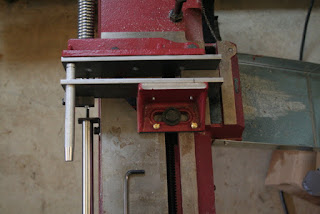I recently completed some modifications to my Harbor Freight 4x6 bandsaw.
I added a collection chute for saw swarf, vise jaw extensions so I can saw shorter pieces of stock, two jack "screws" to help keep the movable jaw from tilting backwards when clamping, and a jack rod to stabilize the movable jaw in the other axis.
The above photo shows the chute on the right. I used some scrap sheet metal left over from our house project and a small metal bender (also purchased at Harbor Freight) to form the sides. I drilled a couple of holes in the casting and chute to bolt the chute to the saw. This arrangement doesn't capture all the swarf but it's far better than my previous setup, which was a paper bag taped to the base with duct tape. It didn't take long for the tape to get crudded up with swarf and cutting oil, so I had to re-attach the bag every time I wanted to use the bandsaw.
You also can see two brass #10-32 "jack screws" on either side of the 14mm bolt used to attach the movable jaw to the screw nut. They are used to stabilize the jaw so it doesn't rotate away from the stock as much when clamping it. I faced off the ends of the screws to maximize the contact area between the screw and bandsaw table; and the brass won't scratch or mar the cast iron (I hope). Finger tight is good enough for this.
The jack rod, on the left side of the jaws, is used to keep the movable jaw from rotating away from stock on the other axis. In use, after the stock is lightly clamped the rod is run up to the fixed jaw and clamped in place. Then the jaw is tightened down to secure the work.
This is a different view showing the jack rod and how I hold it in place. I drilled a 1/2" hole in the plate, then used the band saw to cut a slot from the bottom of plate up to the hole. There are two steel blocks mounted to the plate, on either side of the slot. A 1/4" bolt feeds through the block that is visible in the photo and threads into the other block. Tightening the bolt closes the slot and pinches the rod in place. Actually, I had to widen the slot using a carbide end mill -- otherwise there wasn't quite enough closure to securely hold the jack rod. If need be I can remove the rod for large items I'm cutting -- nothing else protrudes past the surface of the 1/4" thick plate. There is a lot of mechanical advantage at work here -- the screw and the lever action -- so once the bolt is tightened that jack rod is going nowhere.
I'm using a piece of scrap aluminum rod, no need to use steel in this application.


No comments:
Post a Comment